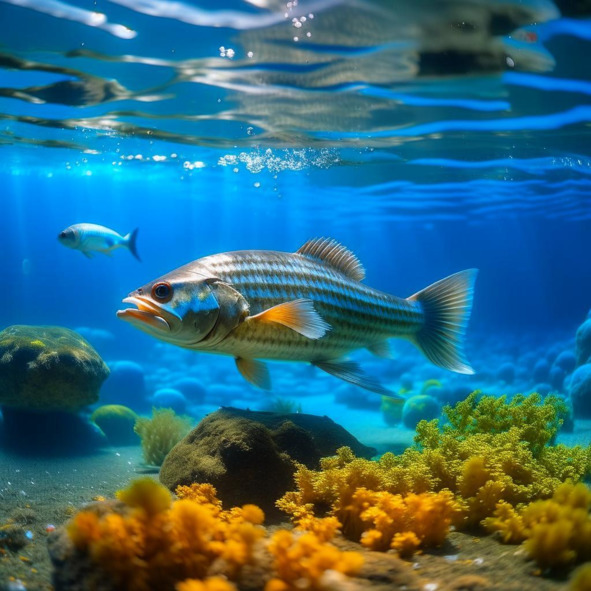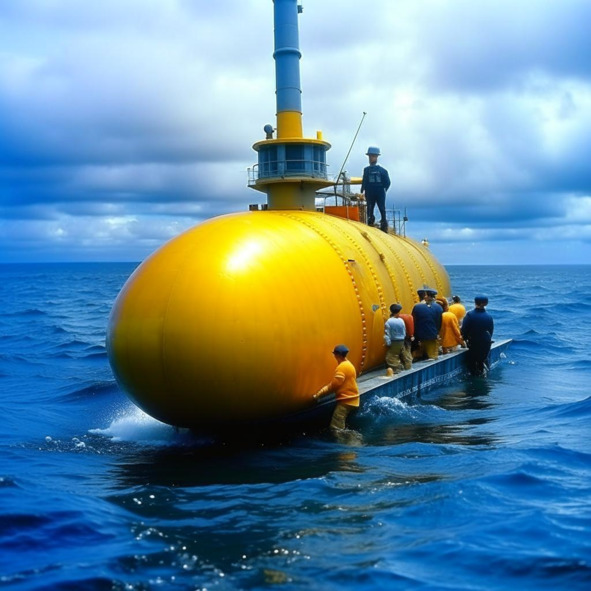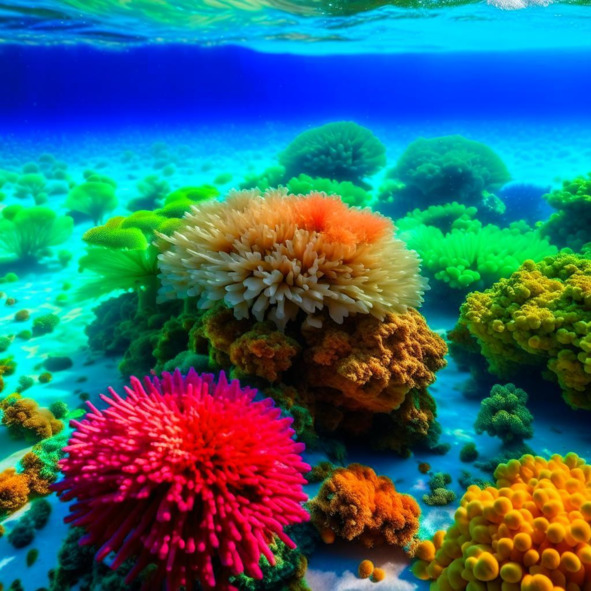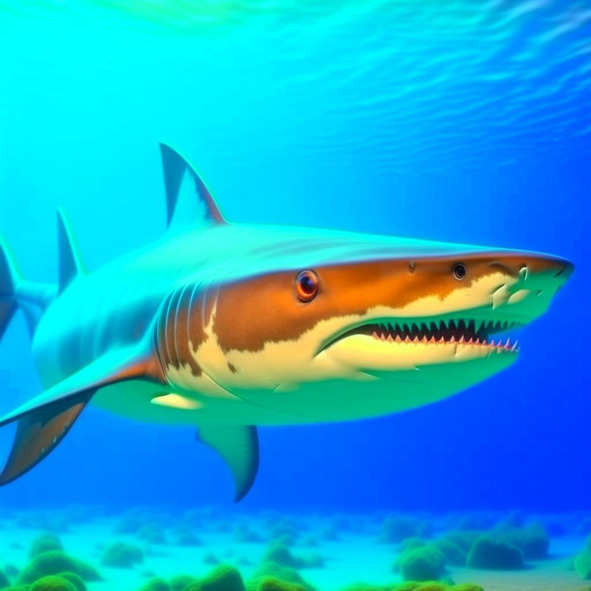
The adventures of Lily McIntyre and Keiren Chasdub in the Pacific Ocean: A Friendship Tale

The adventures of Lily McIntyre and Keiren Chasdub in the Pacific Ocean: A Friendship Tale
Siegfried herzog von Babenberg
© Siegfried herzog von Babenberg, 2023
ISBN 978-5-0060-9291-4
Created with Ridero smart publishing system
English version
CHAPTER 1: A Fascinating Discovery
– Introduction to the protagonist, an aspiring marine biologist
– Setting the scene in the Pacific Ocean, highlighting its vastness and abundance of marine life
– The protagonist’s excitement about the upcoming shark adventure
– Meeting the research team and their mission to study different shark species
Once upon a time, in a land far away, Lived a young marine biologist, eager to play. From the moment she could walk, she adored the sea, Dreaming of exploring its depths, wild and free.
Our protagonist’s name was Lily, skilled and bright, With a passion for sharks that burned oh so bright. She studied their ways, their movements, their grace, Fascinated by these creatures, she longed to embrace.
One sunny morning, in the Pacific they sailed, Aboard the research vessel, they would not fail. The ocean stretched out, as far as the eye could see, Teeming with life, a vast, majestic sea.
Bubbling with excitement, Lily couldn’t wait, For the shark adventure that lay in her fate. Climbing aboard, she met the science team, A group of experts, passionate and keen.
Their mission was clear, to study each shark breed, From hammerheads to great whites, they’d succeed. To understand their habits, their patterns, their ways, And shed light on their secrets, for future days.
The captain, a seasoned sailor with a wise old soul, Shared tales of adventures that made the heart whole. His face weathered by the sun, lines etched with pride, A guide through the ocean, he’d be by their side.
As the boat cruised on, the air filled with cheer, They marveled at the wonders that would soon appear. Each crew member prepared, eager for the unknown, With cameras and notepads, their tools they had shown.
Lily brimmed with joy, her smile lighting the air, For this adventure, she had longed to share. The rhythmic waves whispered secrets untold, As the boat sailed towards a discovery yet unfold.
And so began their journey, in the Pacific so vast, With hearts full of wonder, and spirits steadfast. Side by side, they ventured, to uncover the sea’s lore, A tale of sharks, waiting to be explored.
Chapter 2: Journey to the Deep Blue

Boarding the research vessel was an exhilarating experience. As the team of marine biologists, shark enthusiasts, and other research personnel stepped onto the ship, a sense of excitement and anticipation filled the air. The vessel, named «Ocean Explorer,» was a state-of-the-art research ship equipped with advanced technology and equipment for marine research.
Once on board, the team gathered for a briefing on the upcoming journey. The chief scientist, Dr. Emily Johnson, explained the objectives of the expedition: to study shark behavior and population dynamics in the deep blue ocean. She talked about the equipment they would be using, including underwater cameras, sonar devices, and satellite trackers.

A mysterious device that a group of Navy officers worked with
The first few days of the journey were spent familiarizing themselves with the equipment and technology. The crew gave demonstrations on how to operate the underwater cameras, set up the sonar devices, and track the sharks using satellite tags. The researchers were impressed by the level of precision and detail these tools could provide.
However, the journey had its fair share of challenges. The weather turned unexpectedly rough, causing the ship to rock violently. Some team members struggled with seasickness, but they soldiered on, determined to make the most of their time at sea. They knew that such conditions were not uncommon in the deep blue ocean, and they needed to adjust and adapt quickly.
Another challenge came in the form of wildlife encounters. As the ship sailed further into the open ocean, the researchers spotted various marine creatures, from playful dolphins to majestic whales. These encounters were both awe-inspiring and humbling, reminding the team of the beauty and diversity of the ocean ecosystem. However, they also had to be cautious, as some encounters were with less-friendly creatures like sharks and barracudas.
After several days of sailing, the Ocean Explorer finally arrived at the first location for shark observations. This area, known for its high shark population, was considered a hotspot for studying their behavior. The crew immediately got to work, setting up the underwater cameras and sonar devices to get a comprehensive view of the sharks' movements and interactions.
As soon as the equipment was ready, the team eagerly started their observations. They spent hours watching the live footage from the underwater cameras, analyzing the sharks' behavior and taking notes. Some team members even ventured into the water to get a firsthand experience of swimming alongside these magnificent creatures.
The journey to the deep blue was just beginning, but the team was already full of anticipation and excitement for all the discoveries that lay ahead. They knew that the challenges they faced were only a small part of their incredible adventure in understanding the world of sharks.

Chapter 3: Exploring the World of Sharks
Describing the Great White Shark
The Great White Shark, scientifically known as Carcharodon carcharias, is a large predatory shark species that can be found in coastal waters of various oceans. It is known for its distinct physical appearance and distinguishing features. In terms of physical appearance, the Great White Shark is characterized by its robust body, streamlined shape, and powerful jaws filled with sharp teeth. It typically has a grayish or bluish dorsal surface, which helps it blend in with the surrounding water. The underside of its body is usually white, hence its name. One of the distinguishing features of the Great White Shark is its size. Adult individuals can reach lengths of up to 20 feet (6.1 meters) and weigh over 4,000 pounds (1,800 kilograms). They have a large, triangular dorsal fin and a long, slender tail that allows them to swim swiftly through the water. The Great White Shark is commonly found in coastal waters, although it can also venture into deeper oceanic areas. It has a wide geographical distribution and can be found in various regions, including the waters off the coasts of North America, South Africa, Australia, and New Zealand. Notable behaviors of the Great White Shark include its ability to breach the water surface during hunting, where it lunges vertically to catch prey near the surface. This dramatic behavior is often seen when it hunts seals, sea lions, and other marine mammals. It is also known for its curiosity and inquisitiveness, often approaching boats and divers. The feeding habits of the Great White Shark are primarily carnivorous. It is an apex predator, meaning it sits at the top of the food chain. Its diet consists of a variety of prey, including fish, dolphins, seals, sea lions, and even smaller sharks. The Great White Shark is an opportunistic feeder, taking advantage of available food sources in its environment. 1.2 Exploring the Hammerhead Shark
The Hammerhead Shark is a unique shark species known for its distinct head shape, which resembles a hammer or T-shape. There are various species of hammerhead sharks, but their general characteristics and behaviors are similar. The most distinguishable feature of the Hammerhead Shark is its wide, flattened head, known as a cephalofoil. This unusual head shape gives it several advantages. Firstly, it provides the shark with enhanced vision and a wider field of view, allowing it to locate prey more effectively. Additionally, the hammerhead’s wide head acts as a hydrodynamic «wing» that helps with maneuverability and reduces water resistance while swimming. Behaviorally, Hammerhead Sharks are often observed swimming in schools or groups, displaying social structures unique to their species. These social structures can vary depending on the species, with some exhibiting a strict hierarchy and others displaying more cooperative behaviors. In terms of diet, Hammerhead Sharks have diverse preferences depending on their species. They commonly consume a variety of prey, including fish, cephalopods (such as squid and octopus), and crustaceans. Their hunting strategies often involve using their wide head as a sensory tool to detect electrical signals emitted by their prey. This allows them to locate hidden prey, such as stingrays, buried in the sandy ocean floor. 1.3 Investigating the Giant Whale Shark
The Giant Whale Shark, scientifically known as Rhincodon typus, is the largest known fish species in the world. It is called a «whale shark» due to its immense size, often compared to whales. Despite its size, it is a harmless filter feeder, distinguishing it from other shark species. Physically, the Giant Whale Shark is characterized by its immense size, reaching lengths of up to 40 feet (12 meters) and weighing over 20 tons (18 metric tons). Its body is cylindrical and covered with a unique pattern of dark gray or brownish spots and stripes, which are used for individual identification. The habitat preferences of the Giant Whale Shark include warm tropical and subtropical waters. They can often be found in areas with high plankton concentrations, such as around coral reefs, coastal areas, and upwelling zones. While they prefer warm waters, they can undertake long-distance migrations to follow their food sources. The Giant Whale Shark is a filter feeder, relying on a unique feeding behavior to sustain itself. It opens its large mouth, which can be up to 5 feet (1.5 meters) wide, to engulf massive amounts of water. As the water passes through its gills, specialized filter pads trap plankton and small fish, which the shark feeds on. It has a sieve-like structure in its gills that prevents larger prey from entering its digestive system. Whale sharks play a significant role in the food chain as important consumers of plankton and small fish. Their migration patterns and feeding habits can have impacts on local fish populations and overall oceanic ecosystems. Despite their enormous size, they are generally docile and pose no threat to humans.
2: Observerving Shark Behavior

Conclusion:
Sharks are truly remarkable creatures that are essential for maintaining the delicate balance of our oceans. By understanding their diverse species, behaviors, and role in the ecosystem, we can work towards conserving and protecting these magnificent animals for generations to come.

Chapter 4: Diving into Great White Waters

As dawn broke over the vast expanse of the ocean, the boat slowly approached the popular feeding site known for its great white sharks. The protagonist, a seasoned diver with a thirst for adventure, couldn’t help but feel a mix of exhilaration and fear. This was what they had been waiting for – a chance to dive with the apex predators of the sea.
With their heart pounding in anticipation, the protagonist plunged into the crystal-clear waters. The surface soon disappeared, and the depth revealed a whole new world. Shadows danced in the sunlight, and the diver’s eyes darted around, searching for the telltale signs of the magnificent creatures that lurked beneath.
Suddenly, out of the depths, a massive great white shark emerged. Its sleek, powerful body glided effortlessly through the water, its jaws displaying rows of razor-sharp teeth. In that moment, fear gripped the diver, but it was instantly replaced by awe and respect. The grandeur of this creature, the apex predator of the ocean, left the protagonist humbled and mesmerized.
As the dive continued, more sharks joined the scene. Each encounter was both nerve-wracking and captivating, as the diver witnessed the incredible hunting skills of these majestic creatures. They effortlessly chased down their prey, moving with an agility and precision that left the diver in awe. It was a thrilling experience, a dance between fear and fascination.
Reflecting on the encounter, the diver realized the significant role great white sharks play in the ocean’s intricate food chain. As apex predators, they help maintain balance and stability within the ecosystem. By controlling the populations of their prey, they prevent overpopulation and subsequent depletion of resources. Without great white sharks, the delicate web of life in the ocean would be disrupted, leading to a cascade of negative effects.
Конец ознакомительного фрагмента.
Текст предоставлен ООО «Литрес».
Прочитайте эту книгу целиком, купив полную легальную версию на Литрес.
Безопасно оплатить книгу можно банковской картой Visa, MasterCard, Maestro, со счета мобильного телефона, с платежного терминала, в салоне МТС или Связной, через PayPal, WebMoney, Яндекс.Деньги, QIWI Кошелек, бонусными картами или другим удобным Вам способом.
Вы ознакомились с фрагментом книги.
Для бесплатного чтения открыта только часть текста.
Приобретайте полный текст книги у нашего партнера:
Всего 10 форматов